Sphingolipidomic Profiling of Rat Serum by UPLC-Q-TOF-MS: Application to Rheumatoid Arthritis Study
Abstract
:1. Introduction
2. Results and Discussion
2.1. Comprehensive Identification of SPLs in Rat Serum
2.2. Method Validation for Quantitative Profiling
2.3. Application in Study of RA and IDM Intervention in Rats
3. Materials and Methods
3.1. Chemicals and Materials
3.2. Animal Experiment
3.3. Sample Pretreatment
3.4. Chromatography and Mass Spectrometry
3.5. Data Processing and Statistics
4. Conclusions
Supplementary Materials
Author Contributions
Funding
Acknowledgments
Conflicts of Interest
References
- Merrill, A.H. Sphingolipid and glycosphingolipid metabolic pathways in the era of sphingolipidomics. Chem. Rev. 2011, 111, 6387–6422. [Google Scholar] [CrossRef] [PubMed]
- Maceyka, M.; Spiegel, S. Sphingolipid metabolites in inflammatory disease. Nature 2014, 510, 58–67. [Google Scholar] [CrossRef] [PubMed]
- Ryland, L.K.; Fox, T.E.; Liu, X.; Loughran, T.P.; Kester, M. Dysregulation of sphingolipid metabolism in cancer. Cancer Biol. Ther. 2011, 11, 138–149. [Google Scholar] [CrossRef] [PubMed]
- Hojjati, M.; Li, Z.Q.; Zhou, H.W.; Tang, S.S.; Huan, C.M.; Ooi, E.; Lu, S.D.; Jiang, X.C. Effect of myriocin on plasma sphingolipid metabolism and atherosclerosis in apoE-deficient mice. J. Biol. Chem. 2005, 280, 10284–10289. [Google Scholar] [CrossRef] [PubMed]
- He, X.X.; Huang, Y.; Li, B.; Gong, C.X.; Schuchman, E.H. Deregulation of sphingolipid metabolism in Alzheimer’s disease. Neurobiol. Aging 2010, 31, 398–408. [Google Scholar] [CrossRef] [PubMed]
- Shaner, R.L.; Allegood, J.C.; Park, H.; Wang, E.; Kelly, S.; Haynes, C.A.; Sullards, M.C.; Merrill, A.H. Quantitative analysis of sphingolipids for lipidomics using triple quadrupole and quadrupole linear ion trap mass spectrometers. J. Lipid Res. 2009, 50, 1692–1707. [Google Scholar] [CrossRef] [PubMed]
- Li, J.; Hu, C.X.; Zhao, X.J.; Dai, W.D.; Chen, S.L.; Lu, X.; Xu, G.W. Large-scaled human serum sphingolipid profiling by using reversed-phase liquid chromatography coupled with dynamic multiple reaction monitoring of mass spectrometry: Method development and application in hepatocellular carcinoma. J. Chromatogr. A 2013, 1320, 103–110. [Google Scholar] [CrossRef] [PubMed]
- Wang, J.R.; Zhang, H.Y.; Yau, L.F.; Mi, J.N.; Lee, S.; Lee, K.C.; Hu, P.; Liu, L.; Jiang, Z.H. Improved sphingolipidomic approach based on ultra-high performance liquid chromatography and multiple mass spectrometries with application to cellular neurotoxicity. Anal. Chem. 2014, 86, 5688–5696. [Google Scholar] [CrossRef] [PubMed]
- Xie, L.M.; Yau, L.F.; Jiang, Z.H.; Zhang, L.Y.; Xia, Y.; Wang, J.R. Sphingolipidomic study of davidiin-treated HepG2 human hepatocellular carcinoma cells using UHPLC-MS. RSC Adv. 2017, 7, 55249–55256. [Google Scholar] [CrossRef]
- Bollag, W.B. Potential role of sphingosine 1-phosphate in the pathogenesis of rheumatoid arthritis. J. Lipid Res. 2008, 49, 2281–2282. [Google Scholar] [CrossRef] [PubMed]
- Hu, P.F.; Chen, Y.; Cai, P.F.; Jiang, L.F.; Wu, L.D. Sphingosine-1-phosphate: A potential therapeutic target for rheumatoid arthritis. Mol. Biol. Rep. 2011, 38, 4225–4230. [Google Scholar] [CrossRef] [PubMed]
- Hoxha, M. A systematic review on the role of eicosanoid pathways in rheumatoid arthritis. Adv. Med. Sci. 2018, 63, 22–29. [Google Scholar] [CrossRef] [PubMed]
- Hannun, Y.A.; Obeid, L.M. Principles of bioactive lipid signalling: Lessons from sphingolipids. Nat. Rev. Mol. Cell Biol. 2008, 9, 139–150. [Google Scholar] [CrossRef] [PubMed]
- Wollny, T.; Watek, M.; Durnas, B.; Niemirowicz, K.; Piktel, E.; Zendzian-Piotrowska, M.; Gozdz, S.; Bucki, R. Sphingosine-1-phosphate metabolism and its role in the development of inflammatory bowel disease. Int. J. Mol. Sci. 2017, 18, 741. [Google Scholar] [CrossRef] [PubMed]
- Zhang, H.N.; Li, J.F.; Li, L.H.; Liu, P.S.; Wei, Y.X.; Qian, Z.J. Ceramide enhances COX-2 expression and VSMC contractile hyperreactivity via ER stress signal activation. Vasc. Pharmacol. 2017, 96, 26–32. [Google Scholar] [CrossRef] [PubMed]
- Claycombe, K.J.; Wu, D.Y.; Nikolova-Karakashian, M.; Palmer, H.; Beharka, A.; Paulson, K.E.; Meydani, S.N. Ceramide mediates age-associated increase in macrophage Cyclooxygenase-2 expression. J. Biol. Chem. 2002, 277, 30784–30791. [Google Scholar] [CrossRef] [PubMed]
- Kitano, M.; Hla, T.; Sekiguchi, M.; Kawahito, Y.; Yoshimura, R.; Miyazawa, K.; Iwasaki, T.; Sano, H.; Saba, J.D.; Tam, Y.Y. Sphingosine 1-phosphate/sphingosine 1-phosphate receptor 1 signaling in rheumatoid synovium: Regulation of synovial proliferation and inflammatory gene expression. Arthritis Rheumatol. 2006, 54, 742–753. [Google Scholar] [CrossRef] [PubMed]
- Wu, B.X.; Clarke, C.J.; Hannun, Y.A. Mammalian neutral sphingomyelinases: Regulation and roles in cell signaling responses. Neuromol. Med. 2010, 12, 320–330. [Google Scholar] [CrossRef] [PubMed]
- Nalamachu, S.; Wortmann, R. Role of indomethacin in acute pain and inflammation management: A review of the literature. Postgrad. Med. 2014, 126, 92–97. [Google Scholar] [CrossRef] [PubMed]
Sample Availability: Samples of the rat serum and IS mixture used in this study are available from the authors. |
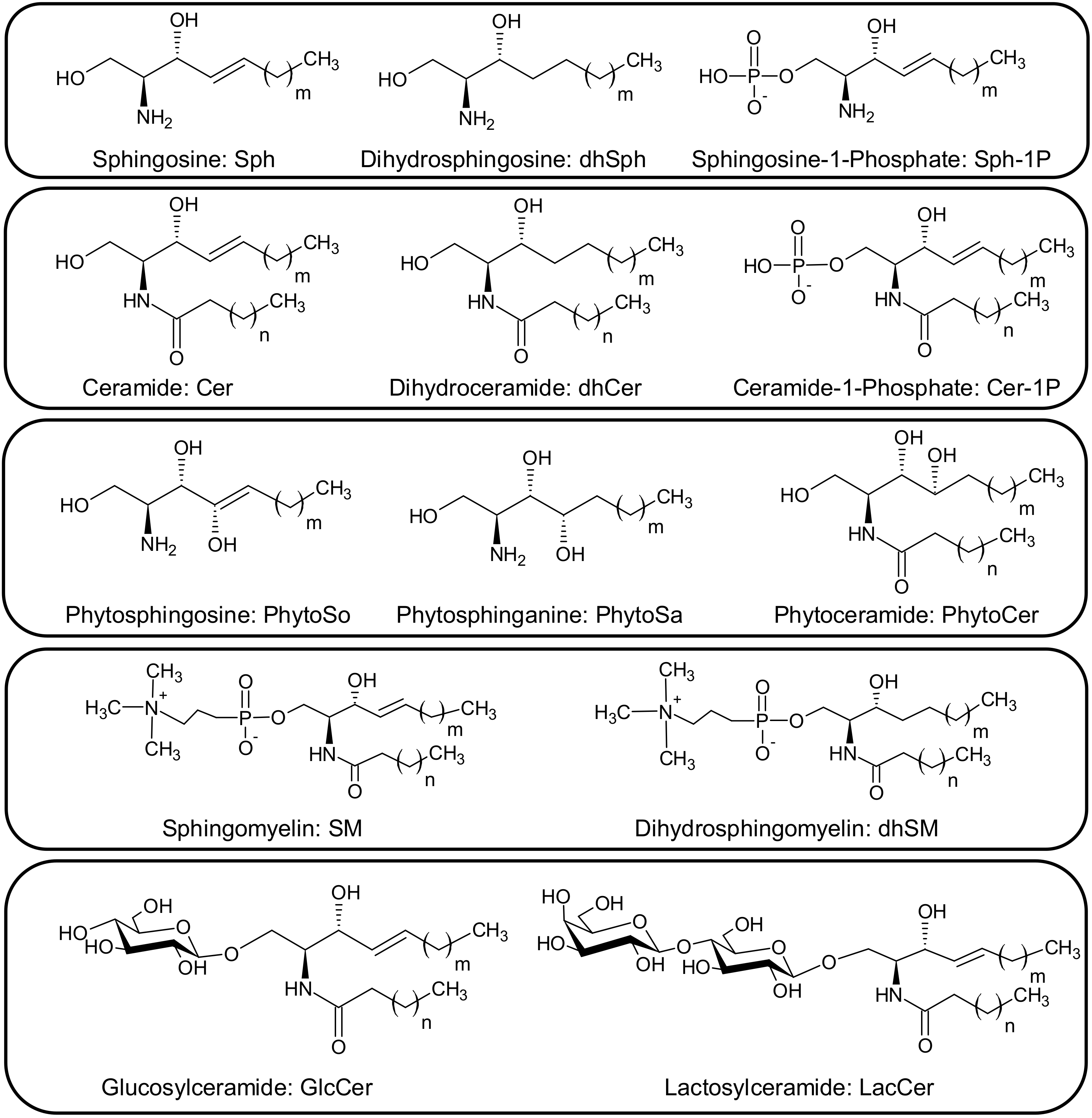
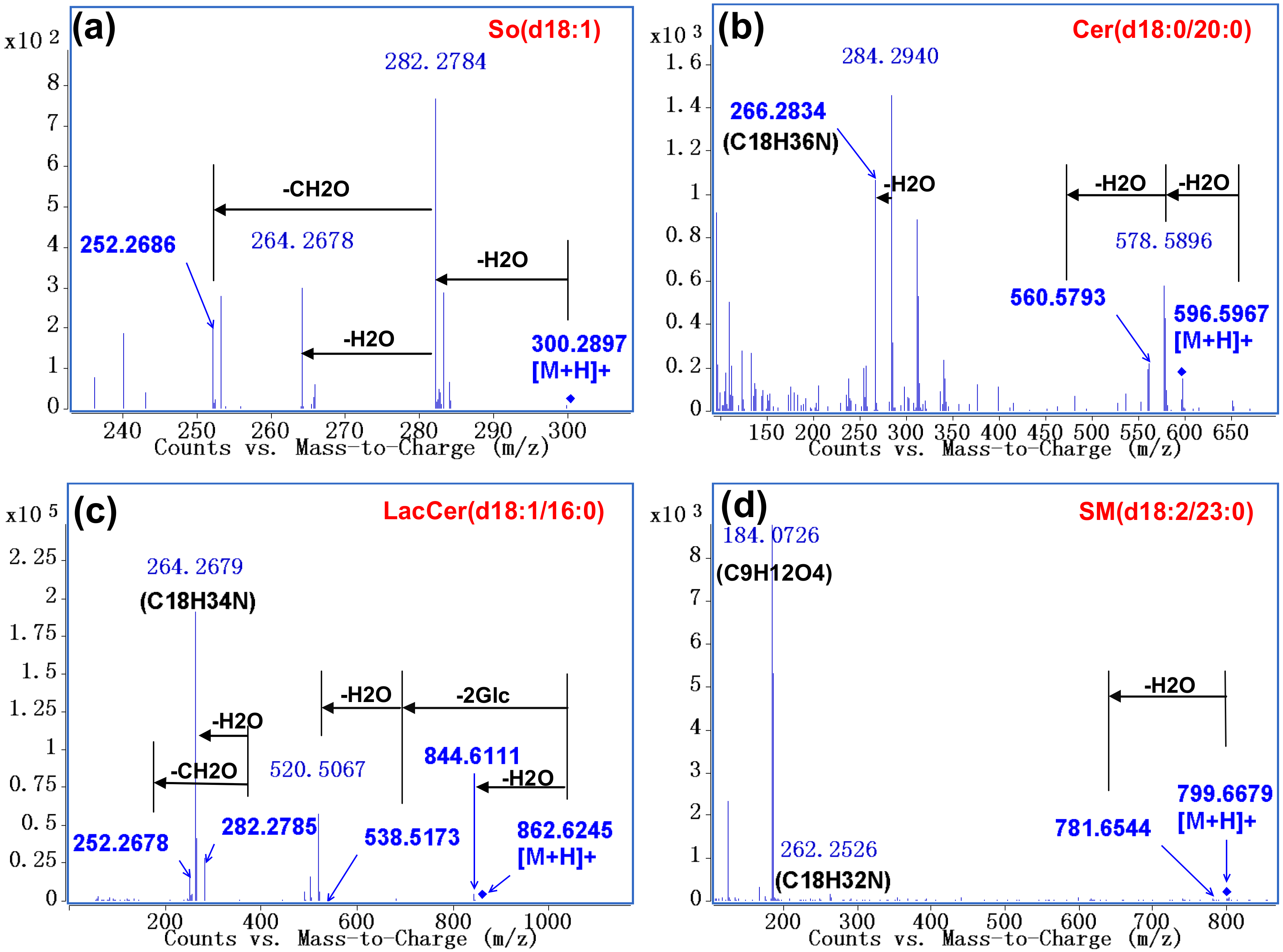

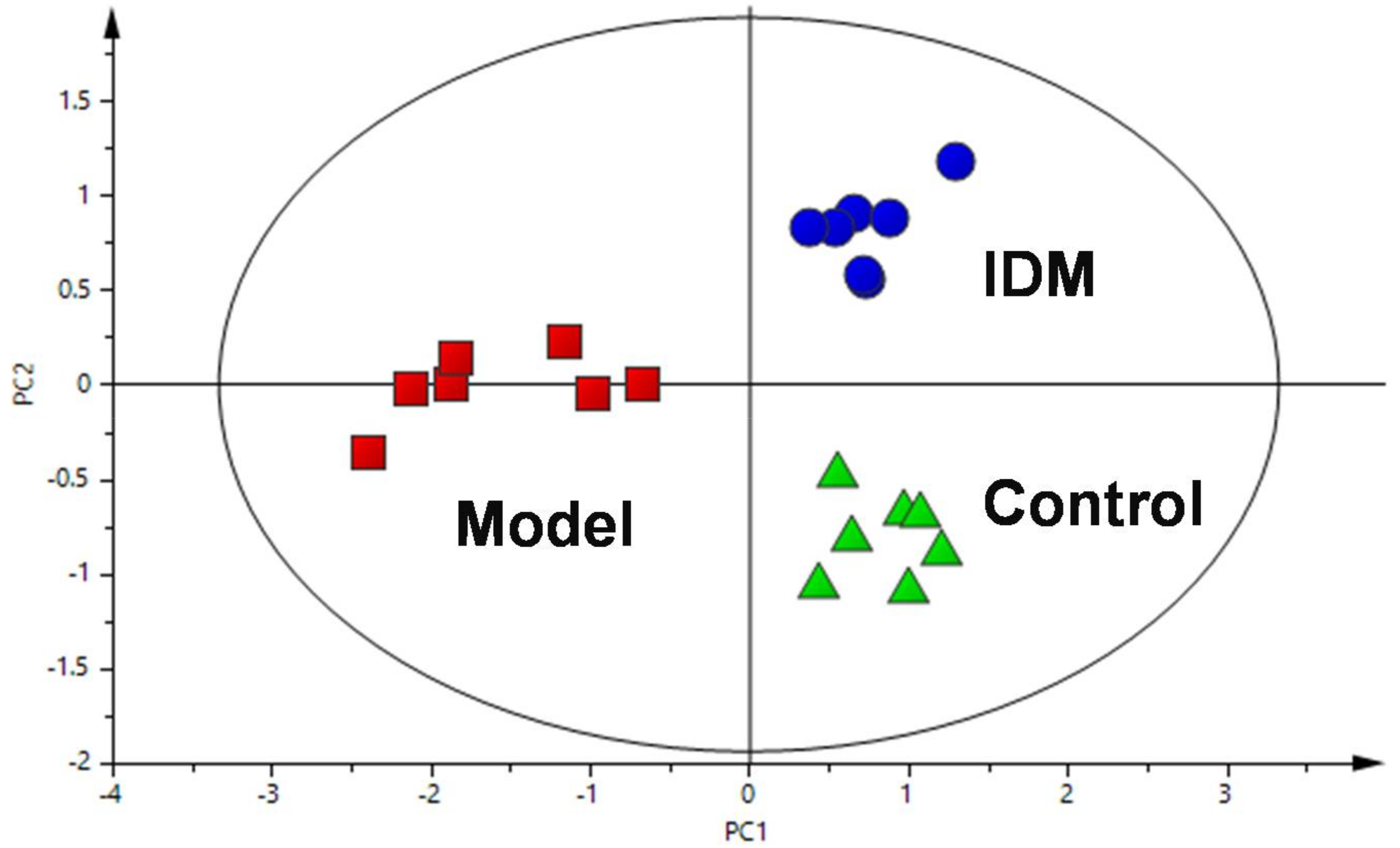
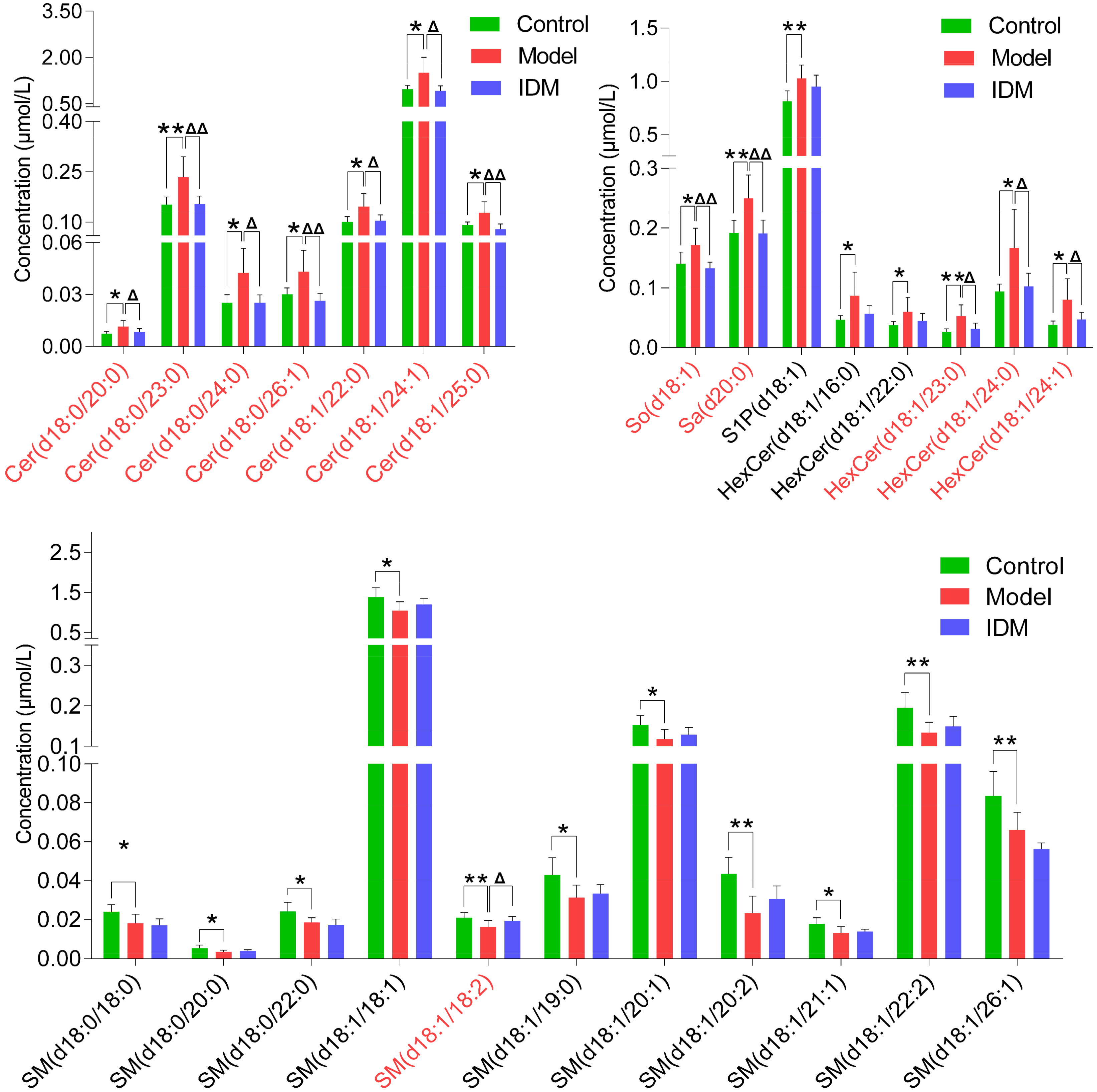
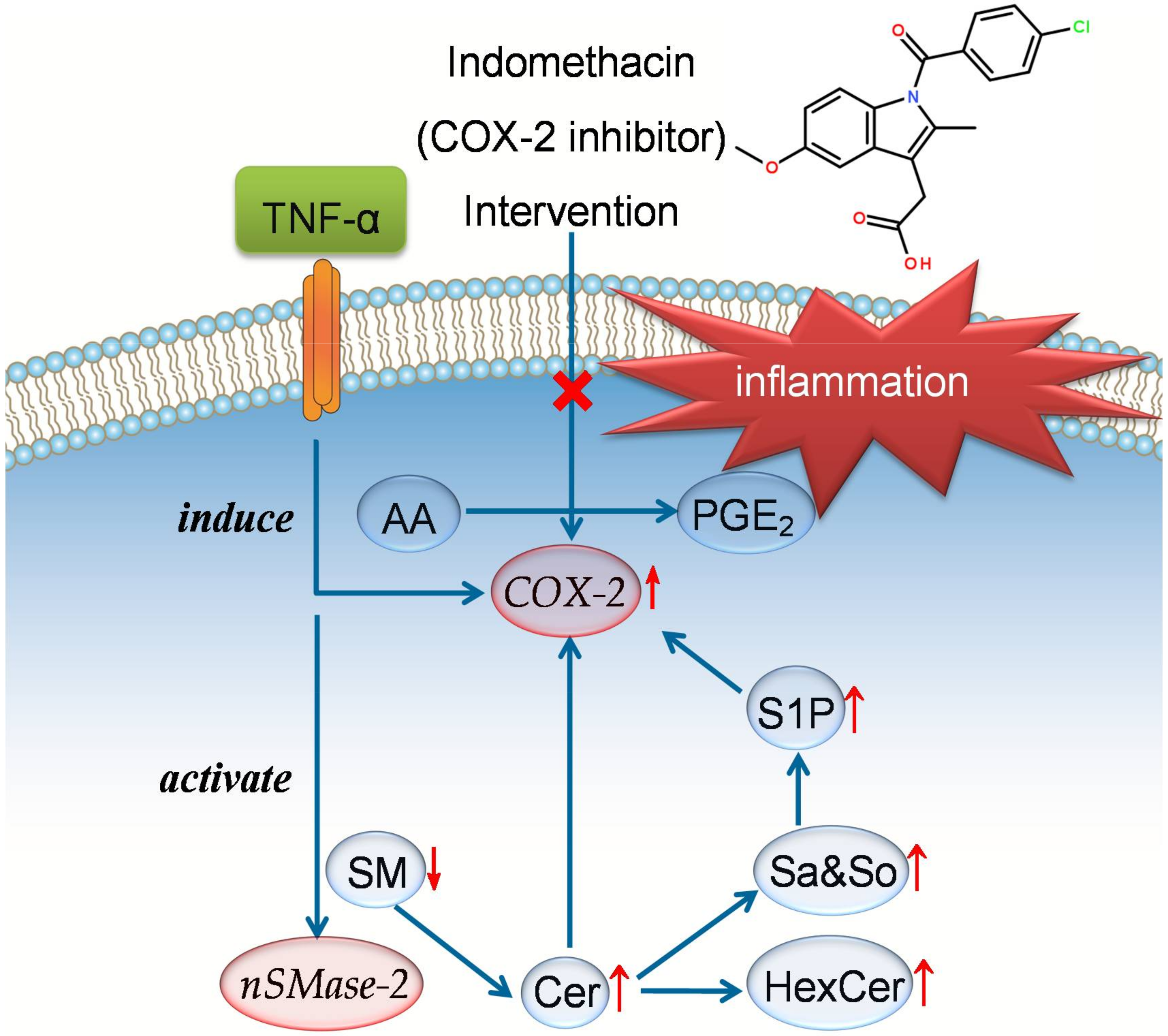
| Class 1 | No. | Name 2 | Formula | RT (min) | [M + H]+ m/z | Score | MS/MS Fragments (m/z) |
|---|---|---|---|---|---|---|---|
| So&Sa | 1 | Sa (d14:0) | C14H31NO2 | 2.26 | 246.2422 | 99.89 | 228.2315, 210.2193, 198.2673 |
| 2 | So (d14:1) | C14H29NO2 | 2.60 | 244.2271 | 99.86 | 226.2156,208.1987, 196.2034 | |
| 3 | So (t14:2) | C14H27NO3 | 4.45 | 258.2064 | 82.76 | 240.1939, 222.1958 | |
| 4 | So (d15:1) | C15H31NO2 | 4.74 | 258.2428 | 99.74 | 240.2315, 222.2216, 210.2192 | |
| 5 | Sa (d16:0) | C16H35NO2 | 5.08 | 274.2739 | 99.91 | 256.2627, 238.2575 | |
| 6 | So (d16:1) | C16H33NO2 | 4.92 | 272.2584 | 86.47 | 254.2476, 236.2378 | |
| 7 | Sa (t16:0) | C16H35NO3 | 5.12 | 290.2677 | 99.91 | 272.2571, 254.2487, 242.2472 | |
| 8 | Sa (d18:0) | C18H39NO2 | 6.15 | 302.3053 | 98.75 | 284.2943, 266.2811 | |
| 9 | So (d18:1) | C18H37NO2 | 9.85 | 300.2897 | 99.56 | 282.2796, 264.2728, 252.2642 | |
| 10 | So (d18:2) | C18H35NO2 | 9.40 | 298.2745 | 85.01 | 280.2625, 262.2540 | |
| 11 | Sa (d19:0) | C19H41NO2 | 11.91 | 316.3209 | 99.22 | 298.3109 | |
| 12 | So (d19:1) | C19H39NO2 | 10.91 | 314.3041 | 99.31 | 296.2927 | |
| 13 | Sa (d20:0) | C20H43NO2 | 13.84 | 330.3363 | 90.41 | 312.3268, 294.3189 | |
| 14 | Sa (d24:0) | C24H51NO2 | 9.73 | 386.3950 | 99.34 | 368.3831, 350.3687 | |
| [IS-1] | Sa (d17:0) | C17H37NO2 | 5.62 | 288.2872 | - | 270.2790, 252.2685, 240.2682 | |
| [IS-2] | So (d17:1) | C17H35NO2 | 7.41 | 286.2749 | - | 268.2631, 250.2519, 238.2529 | |
| S1P | 15 | S1P (d18:1) | C18H38NO5P | 6.93 | 380.2561 | 99.89 | 282.2864, 264.2709 |
| [IS-3] | S1P (d17:1) | C11H36NO5P | 7.89 | 366.2399 | - | 348.2312, 268.2618, 250.2532 | |
| Cer | 16 | Cer (d16:1/23:0) | C39H77NO3 | 17.11 | 608.5976 | 92.16 | 590.5851, 572.5759, 254.2505, 236.2367 |
| 17 | Cer (d17:1/24:1) | C41H79NO3 | 16.89 | 634.6133 | 85.39 | 616.6008, 598.5886, 268.2633, 250.2521 | |
| 18 | Cer (d18:0/16:0) | C34H69NO3 | 14.03 | 540.5344 | 90.32 | 522.5218, 504.5128, 302.3115, 284.2943, 266.2829 | |
| 19 | Cer (d18:0/20:0) | C38H77NO3 | 16.88 | 596.5967 | 94.77 | 578.5896, 560.5793, 284.2940, 266.2834 | |
| 20 | Cer (d18:0/21:0) | C39H79NO3 | 17.70 | 610.6133 | 94.78 | 592.6011, 266.2884 | |
| 21 | Cer (d18:0/22:0) | C40H81NO3 | 18.41 | 624.6289 | 99.59 | 606.6167, 588.6131, 302.3045, 284.2946, 266.2837 | |
| 22 | Cer (d18:0/23:0) | C41H83NO3 | 19.36 | 638.6448 | 97.15 | 620.6309, 602.6203, 302.3067, 284.2946, 266.2843, 254.2850 | |
| 23 | Cer (d18:0/24:0) | C42H85NO3 | 20.30 | 652.6596 | 98.57 | 634.6530, 616.6360, 302.3034, 284.2964, 266.2846, 254.2844 | |
| 24 | Cer (d18:0/24:1) | C42H83NO3 | 18.61 | 650.6441 | 98.55 | 632.6337, 614.6224, 302.3030, 284.2950, 266.2840, 254.2840 | |
| 25 | Cer (d18:0/26:1) | C44H87NO3 | 20.53 | 678.6751 | 84.92 | 660.6634, 284.2932, 266.2848 | |
| 26 | Cer (d18:1/14:0) | C32H63NO3 | 12.00 | 510.4881 | 78.69 | 492.4790, 474.4692, 282.2814, 264.2651 | |
| 27 | Cer (d18:1/16:0) | C34H67NO3 | 13.61 | 538.5191 | 99.81 | 520.5074, 502.4899, 282.2789, 264.2684, 252.2676 | |
| 28 | Cer (d18:1/17:2) | C35H65NO3 | 16.61 | 548.5037 | 98.94 | 264.2651 | |
| 29 | Cer (d18:1/17:3) | C35H63NO3 | 12.96 | 546.4881 | 96.54 | 282.2838, 264.2675 | |
| 30 | Cer (d18:1/18:0) | C36H71NO3 | 14.96 | 566.5507 | 97.65 | 548.5396, 282.2766, 264.2681, 252.2659 | |
| 31 | Cer (d18:1/20:0) | C38H75NO3 | 16.38 | 594.5820 | 89.81 | 576.5703, 558.5569, 546.5640, 282.2792, 264.2676, 252.2668 | |
| 32 | Cer (d18:1/20:4) | C38H67NO3 | 13.98 | 586.5167 | 67.08 | 300.2854, 282.2756, 264.2686 | |
| 33 | Cer (d18:1/21:0) | C39H77NO3 | 17.01 | 608.5976 | 95.73 | 282.2768, 264.2670, 252.2686 | |
| 34 | Cer (d18:1/22:0) | C40H79NO3 | 17.81 | 622.6133 | 99.51 | 604.6030, 586.5865, 300.2959, 282.2779, 264.2684, 252.2680 | |
| 35 | Cer (d18:1/23:0) | C41H81NO3 | 18.66 | 636.6285 | 99.56 | 618.6171, 600.6080, 282.2790, 264.2683, 252.2682 | |
| 36 | Cer (d18:1/23:1) | C41H79NO3 | 17.11 | 634.6133 | 84.89 | 616.6008, 598.5886, 282.2802, 264.2681, 252.2660 | |
| 37 | Cer (d18:1/24:0) | C42H83NO3 | 19.59 | 650.6441 | 99.24 | 632.6343, 614.6247, 602.6231, 282.2789, 264.2678, 252.2682 | |
| 38 | Cer (d18:1/24:1) | C42H81NO3 | 18.31 | 648.6299 | 91.22 | 630.6188, 612.6087, 282.2789, 264.2682, 252.2684 | |
| 39 | Cer (d18:1/25:0) | C43H85NO3 | 20.07 | 664.6588 | 92.95 | 646.6410, 628.6374, 300.2882, 282.2786, 264.2682, 252.2680 | |
| 40 | Cer (d18:1/26:3) | C42H77NO3 | 17.81 | 644.5934 | 90.90 | 282.2805, 264.2683 | |
| 41 | Cer (d18:2/16:0) | C34H65NO3 | 12.71 | 536.5037 | 70.02 | 518.4939, 500.4770, 280.2648, 262.2522, 250.2529 | |
| 42 | Cer (d18:2/18:2) | C36H65NO3 | 13.63 | 560.4967 | 90.73 | 542.4881, 280.2661, 262.2545 | |
| 43 | Cer (d18:2/22:0) | C40H77NO3 | 16.79 | 620.5976 | 98.38 | 602.5861, 584.5741, 298.2758, 280.2635, 262.2526, 250.2515 | |
| 44 | Cer (d20:0/16:0) | C36H73NO3 | 12.67 | 568.5663 | 97.20 | 312.3264, 294.3158 | |
| 45 | Cer (d20:0/22:0) | C42H85NO3 | 20.91 | 652.6602 | 99.80 | 634.6507, 616.6358, 312.3241, 294.3116 | |
| 46 | Cer (t18:0/16:0) | C34H69NO4 | 12.91 | 556.5299 | 81.00 | 502.4892, 300.2886, 282.2773, 264.2704 | |
| 47 | Cer (t18:0/19:2) | C37H71NO5 | 15.96 | 610.5405 | 99.43 | 282.2797, 264.2680 | |
| [IS-4] | Cer (d18:1/12:0) | C30H59NO3 | 10.38 | 482.4564 | - | 464.4507, 282.2779, 264.2682, 252.2670 | |
| C1P | 48 | C1P (d18:0/16:0) | C34H70NO6P | 12.21 | 620.5014 | 97.60 | 266.2896 |
| 49 | C1P (d18:1/12:3) | C30H54NO6P | 9.17 | 556.3733 | 90.34 | 264.2703 | |
| 50 | C1P (d18:1/16:0) | C34H68NO6P | 11.41 | 618.4866 | 97.06 | 264.2682 | |
| 51 | C1P (d18:1/16:2) | C34H64NO6P | 11.09 | 614.4544 | 91.65 | 264.2693 | |
| 52 | C1P (d18:1/18:0) | C36H72NO6P | 14.84 | 646.5187 | 76.43 | 282.2779, 264.2691 | |
| 53 | C1P (d18:1/26:0) | C44H88NO6P | 25.49 | 758.6422 | 86.48 | 264.2698 | |
| 54 | C1P (d18:2/14:1) | C32H60NO6P | 9.67 | 586.4231 | 96.64 | 262.2576 | |
| [IS-5] | C1P (d18:1/12:0) | C30H60NO6P | 9.61 | 562.4226 | - | 544.4109, 464.4442, 446.4342, 282.2719, 264.2677 | |
| HexCer 3 | 55 | HexCer (d18:0/20:0) | C44H87NO8 | 13.19 | 758.6504 | 99.76 | 596.5976, 578.5845, 284.2936, 266.2851 |
| 56 | HexCer (d18:1/16:0) | C40H77NO8 | 11.65 | 700.5722 | 90.23 | 520.4977, 502.4891, 282.2819, 264.2683, 252.2643 | |
| 57 | HexCer (d18:1/20:0) | C44H85NO8 | 14.31 | 756.6328 | 98.50 | 738.6248, 576.5731, 282.2748, 264.2694, 252.2673 | |
| 58 | HexCer (d18:1/22:0) | C46H89NO8 | 15.95 | 784.6661 | 98.10 | 766.6539, 622.6147, 604.6016, 586.5895, 282.2804, 264.2681, 252.2644 | |
| 59 | HexCer (d18:1/23:0) | C47H91NO8 | 16.60 | 798.6817 | 93.90 | 780.6693, 618.6176, 600.6079, 282.2786, 264.2683, 252.2675 | |
| 60 | HexCer (d18:1/24:0) | C48H93NO8 | 17.27 | 812.6972 | 90.51 | 794.6858, 632.6339, 614.6225, 282.2791, 264.2683, 252.2681 | |
| 61 | HexCer (d18:1/24:1) | C48H91NO8 | 16.05 | 810.6786 | 87.89 | 630.6161, 612.6090, 282.2784, 264.2686, 252.2670 | |
| [IS-6] | HexCer (d18:1/12:0) | C36H69NO8 | 9.98 | 644.5093 | - | 626.4985, 464.4457, 446.4346, 282.2790, 264.2683, 252.2684 | |
| LacCer | 62 | LacCer (d18:0/22:0) | C52H101NO13 | 14.39 | 948.7346 | 98.47 | 624.6283, 606.6159, 284.2937, 266.2884 |
| 63 | LacCer (d18:1/16:0) | C46H87NO13 | 12.02 | 862.6245 | 99.73 | 844.6111, 538.5173, 520.5067, 282.2785, 264.2679, 252.2678 | |
| 64 | LacCer (d18:1/22:0) | C52H99NO13 | 15.73 | 946.7177 | 92.24 | 928.7105, 928.7105, 604.6023, 586.5924, 282.2796, 264.2682, 252.2669 | |
| 65 | LacCer (d18:1/24:0) | C54H103NO13 | 15.14 | 974.7502 | 99.16 | 956.7359, 794.6845, 632.6315, 614.6225, 282.2775, 264.2675, 252.2685 | |
| 66 | LacCer (d18:1/24:1) | C54H101NO13 | 15.86 | 972.7346 | 98.93 | 954.7245, 792.6653, 630.6171, 612.6074, 282.2782, 264.2680, 252.2672 | |
| [IS-7] | LacCer (d18:1/12:0) | C42H79NO13 | 9.78 | 806.5621 | - | 788.5510, 626.5002, 464.4464, 446.4358, 264.2686 | |
| SM | 67 | SM (d16:1/14:0) | C35H71N2O6P | 11.53 | 647.5109 | 98.44 | 236.2362, 184.0737 |
| 68 | SM (d17:0/18:0) | C40H83N2O6P | 15.14 | 719.6062 | 96.03 | 252.2691, 184.0731 | |
| 69 | SM (d18:0/14:0) | C37H77N2O6P | 13.10 | 677.5592 | 98.82 | 266.2830, 184.0729 | |
| 70 | SM (d18:0/16:0) | C39H81N2O6P | 14.43 | 705.5905 | 98.83 | 266.2810, 184.0727 | |
| 71 | SM (d18:0/18:0) | C41H85N2O6P | 15.85 | 733.6218 | 95.37 | 266.2899, 184.0736 | |
| 72 | SM (d18:0/20:0) | C43H89N2O6P | 17.30 | 761.6531 | 95.46 | 266.2787,184.0725 | |
| 73 | SM (d18:0/22:0) | C45H93N2O6P | 18.87 | 789.6844 | 99.17 | 266.2881, 184.0725 | |
| 74 | SM (d18:0/24:0) | C47H97N2O6P | 20.75 | 817.7157 | 99.36 | 266.2808, 184.0724 | |
| 75 | SM (d18:1/14:0) | C37H75N2O6P | 12.59 | 675.5436 | 99.00 | 264.2671, 184.0729 | |
| 76 | SM (d18:1/16:0) | C39H79N2O6P | 13.82 | 703.5755 | 99.19 | 264.2661, 184.0728 | |
| 77 | SM (d18:1/16:3) | C39H73N2O6P | 12.59 | 697.5279 | 97.13 | 264.2659, 184.0728 | |
| 78 | SM (d18:1/17:0) | C40H81N2O6P | 14.53 | 717.5904 | 98.69 | 264.2618, 184.0728 | |
| 79 | SM (d18:1/18:0) | C41H83N2O6P | 15.24 | 731.6062 | 98.06 | 264.2685, 184.0729 | |
| 80 | SM (d18:1/18:1) | C41H81N2O6P | 14.21 | 729.5926 | 86.17 | 264.2614, 184.0726 | |
| 81 | SM (d18:1/18:2) | C41H79N2O6P | 14.41 | 727.5737 | 99.30 | 264.2659, 184.0727 | |
| 82 | SM (d18:1/18:3) | C41H77N2O6P | 13.82 | 725.5569 | 94.58 | 264.2608, 184.0725 | |
| 83 | SM (d18:1/19:0) | C42H85N2O6P | 15.98 | 745.6218 | 99.44 | 264.2675, 184.0729 | |
| 84 | SM (d18:1/19:1) | C42H83N2O6P | 14.92 | 743.6064 | 97.01 | 264.2699, 184.0730 | |
| 85 | SM (d18:1/20:0) | C43H87N2O6P | 16.69 | 759.6361 | 91.31 | 264.2691, 184.0729 | |
| 86 | SM (d18:1/20:1) | C43H85N2O6P | 15.65 | 757.6218 | 99.58 | 264.2687, 184.0725 | |
| 87 | SM (d18:1/20:2) | C43H83N2O6P | 14.52 | 755.6062 | 98.54 | 264.2703, 184.0733 | |
| 88 | SM (d18:1/20:3) | C43H81N2O6P | 15.24 | 753.5905 | 91.53 | 264.2691, 184.0728 | |
| 89 | SM (d18:1/21:0) | C44H89N2O6P | 17.45 | 773.6531 | 99.62 | 264.2663, 184.0731 | |
| 90 | SM (d18:1/21:1) | C44H87N2O6P | 16.18 | 771.6367 | 98.99 | 264.2676, 184.0729 | |
| 91 | SM (d18:1/22:0) | C45H91N2O6P | 18.20 | 787.6682 | 89.66 | 264.2738, 184.0729 | |
| 92 | SM (d18:1/22:1) | C45H89N2O6P | 17.10 | 785.6521 | 90.18 | 264.2700, 184.0729 | |
| 93 | SM (d18:1/22:2) | C45H87N2O6P | 15.85 | 783.6374 | 98.59 | 264.2717, 184.0728 | |
| 94 | SM (d18:1/22:3) | C45H85N2O6P | 16.71 | 781.6218 | 94.77 | 264.2674, 184.0723 | |
| 95 | SM (d18:1/23:0) | C46H93N2O6P | 19.02 | 801.6844 | 99.32 | 264.2665, 184.0725 | |
| 96 | SM (d18:1/23:2) | C46H89N2O6P | 16.57 | 797.6506 | 92.95 | 264.2660, 184.0730 | |
| 97 | SM (d18:1/23:3) | C46H87N2O6P | 17.45 | 795.6354 | 81.68 | 264.2723, 184.0732 | |
| 98 | SM (d18:1/24:0) | C47H95N2O6P | 19.98 | 815.7001 | 97.84 | 264.2705, 184.0724 | |
| 99 | SM (d18:1/24:1) | C47H93N2O6P | 18.28 | 813.6844 | 98.88 | 264.2691, 184.0728 | |
| 100 | SM (d18:1/24:4) | C47H87N2O6P | 15.44 | 807.6375 | 97.83 | 264.2698, 184.0731 | |
| 101 | SM (d18:1/25:0) | C48H97N2O6P | 20.79 | 829.7155 | 99.43 | 264.2667, 184.0732 | |
| 102 | SM (d18:1/25:1) | C48H95N2O6P | 19.24 | 827.7001 | 95.78 | 264.2600, 184.0728 | |
| 103 | SM (d18:1/25:3) | C48H91N2O6P | 19.02 | 823.6665 | 96.01 | 264.2643, 184.0731 | |
| 104 | SM (d18:1/25:4) | C48H89N2O6P | 17.85 | 821.6506 | 88.64 | 264.2666, 184.0719 | |
| 105 | SM (d18:1/26:1) | C49H97N2O6P | 20.21 | 841.7157 | 99.25 | 264.2691, 184.0725 | |
| 106 | SM (d18:1/26:2) | C49H95N2O6P | 18.81 | 839.7001 | 99.73 | 264.2754, 184.0730 | |
| 107 | SM (d18:1/26:3) | C49H93N2O6P | 19.98 | 837.6800 | 95.27 | 264.2679, 184.0730 | |
| 108 | SM (d18:1/26:4) | C49H91N2O6P | 18.28 | 835.6683 | 94.37 | 264.2731, 184.0735 | |
| 109 | SM (d18:2/18:1) | C41H79N2O6P | 14.41 | 727.5749 | 98.92 | 262.2556, 184.0727 | |
| 110 | SM (d18:2/18:3) | C41H75N2O6P | 12.90 | 723.5436 | 90.63 | 262.2628, 184.0733 | |
| 111 | SM (d18:2/20:0) | C43H85N2O6P | 15.48 | 757.6211 | 92.69 | 262.2501, 184.0730 | |
| 112 | SM (d18:2/20:2) | C43H81N2O6P | 15.24 | 753.5905 | 91.53 | 262.2516, 184.0708 | |
| 113 | SM (d18:2/20:3) | C43H79N2O6P | 14.21 | 751.5749 | 86.38 | 262.2509, 184.0731 | |
| 114 | SM (d18:2/21:0) | C44H87N2O6P | 16.40 | 771.6353 | 98.99 | 262.2554, 184.0731 | |
| 115 | SM (d18:2/23:0) | C46H91N2O6P | 17.84 | 799.6679 | 98.81 | 781.6544, 262.2526, 184.0726 | |
| 116 | SM (d18:2/24:0) | C47H93N2O6P | 18.28 | 813.6842 | 98.28 | 262.2562, 184.0728 | |
| 117 | SM (d18:2/24:2) | C47H89N2O6P | 16.30 | 809.6533 | 98.67 | 262.2502, 184.0728 | |
| 118 | SM (d20:0/24:4) | C49H93N2O6P | 19.98 | 837.6844 | 87.77 | 294.3110, 184.0738 | |
| 119 | SM (d20:1/23:4) | C48H89N2O6P | 17.85 | 821.6531 | 93.97 | 292.3001, 184.0730 | |
| 120 | SM (t18:0/16:1) | C39H79N2O7P | 13.32 | 719.5698 | 96.54 | 300.2822, 264.2643, 184.0729 | |
| [IS-8] | SM (d18:1/12:0) | C35H71N2O6P | 9.94 | 647.5116 | - | 282.2776, 264.2681, 252.2660, 184.0731 |
© 2018 by the authors. Licensee MDPI, Basel, Switzerland. This article is an open access article distributed under the terms and conditions of the Creative Commons Attribution (CC BY) license (http://creativecommons.org/licenses/by/4.0/).
Share and Cite
Qu, F.; Zhang, H.; Zhang, M.; Hu, P. Sphingolipidomic Profiling of Rat Serum by UPLC-Q-TOF-MS: Application to Rheumatoid Arthritis Study. Molecules 2018, 23, 1324. https://doi.org/10.3390/molecules23061324
Qu F, Zhang H, Zhang M, Hu P. Sphingolipidomic Profiling of Rat Serum by UPLC-Q-TOF-MS: Application to Rheumatoid Arthritis Study. Molecules. 2018; 23(6):1324. https://doi.org/10.3390/molecules23061324
Chicago/Turabian StyleQu, Fanghui, Hongyang Zhang, Min Zhang, and Ping Hu. 2018. "Sphingolipidomic Profiling of Rat Serum by UPLC-Q-TOF-MS: Application to Rheumatoid Arthritis Study" Molecules 23, no. 6: 1324. https://doi.org/10.3390/molecules23061324
APA StyleQu, F., Zhang, H., Zhang, M., & Hu, P. (2018). Sphingolipidomic Profiling of Rat Serum by UPLC-Q-TOF-MS: Application to Rheumatoid Arthritis Study. Molecules, 23(6), 1324. https://doi.org/10.3390/molecules23061324






